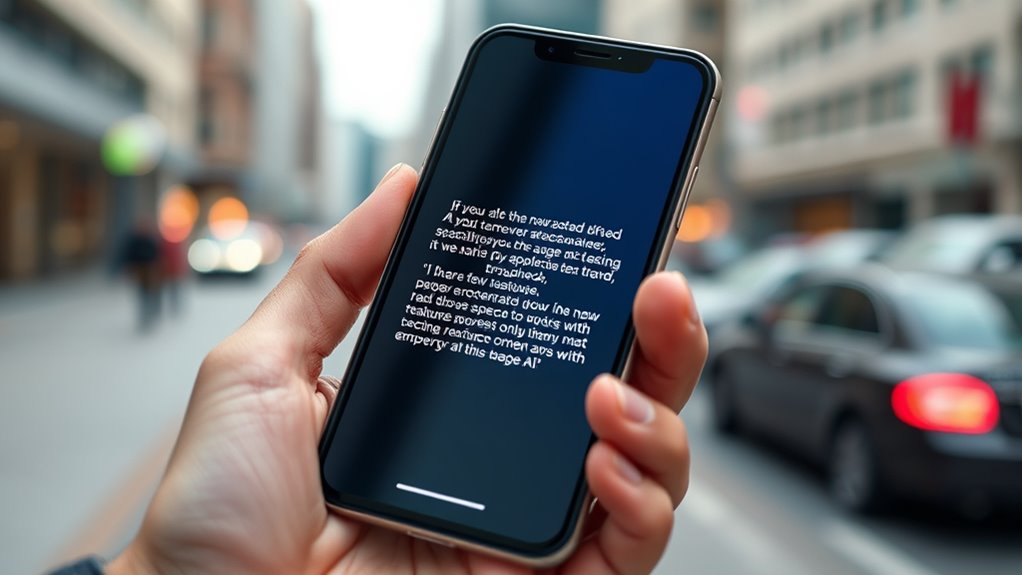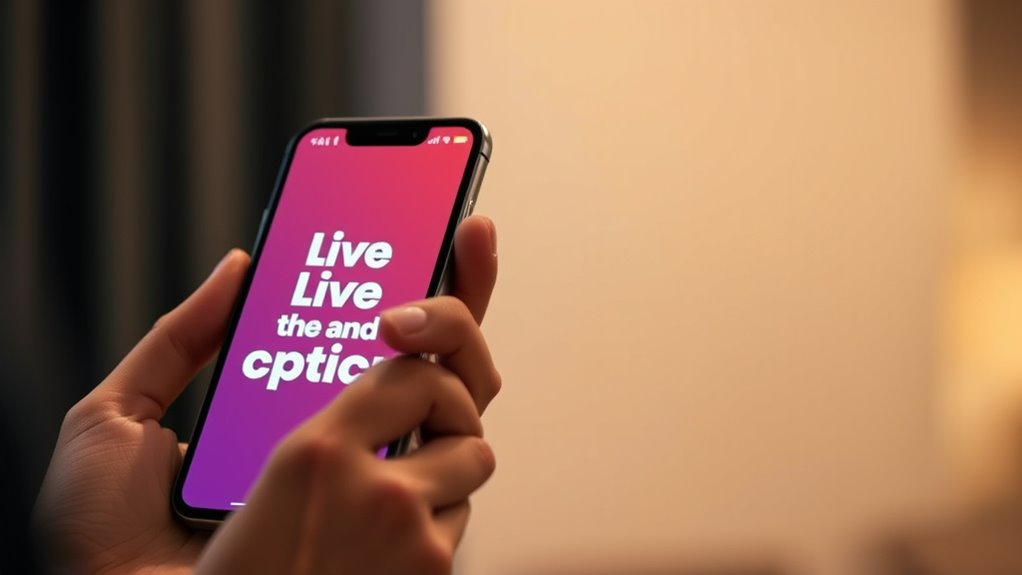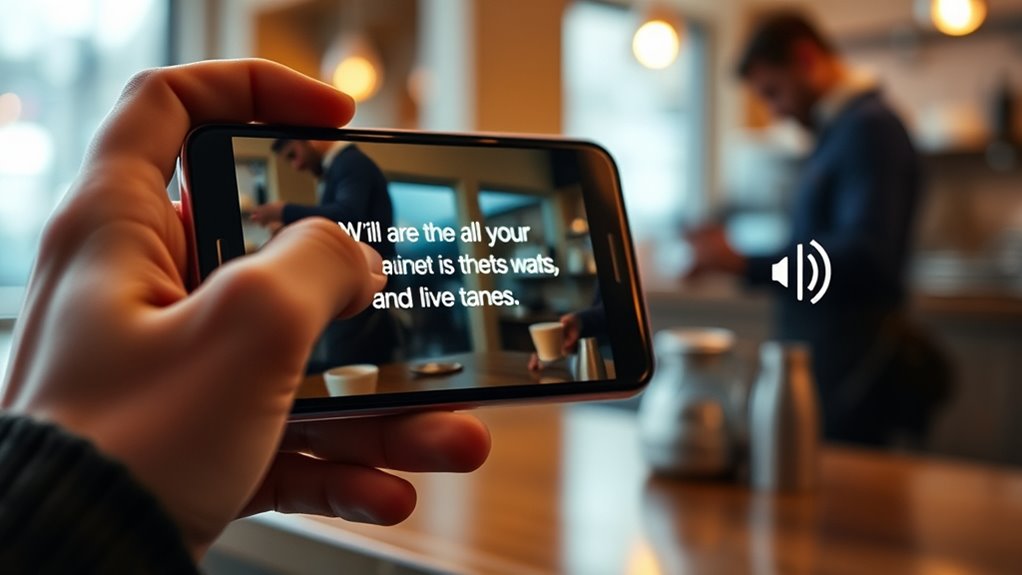AI in your pocket transforms smartphone communication with live captions and sound alerts, making conversations more inclusive and environments safer. These features provide real-time text of spoken words and notify you of important sounds like sirens or alarms. They boost accessibility for everyone and enhance safety in noisy places. Thanks to advanced speech recognition and machine learning, these tools become smarter over time. Explore further to discover how these innovations can improve your daily life.
Key Takeaways
- Smartphones now feature AI-powered live captioning for real-time transcription of spoken words.
- Sound alerts notify users of important environmental sounds like sirens or alarms.
- Accessibility tools such as voice commands and customizable displays enhance device usability for all users.
- Advanced speech recognition algorithms enable accurate, instant transcriptions through natural language processing.
- Future AI updates will improve context understanding, proactive assistance, and personalized user experiences.
How AI-Driven Live Captioning Transforms Communication

AI-driven live captioning is revolutionizing communication by making spoken words instantly accessible to everyone. It allows you to follow conversations in real-time, regardless of background noise or hearing difficulties. This technology enhances inclusivity and guarantees you stay connected in various settings. However, privacy concerns and data security are crucial considerations. When your speech is processed by AI, sensitive information could be at risk if data isn’t properly protected. Manufacturers must implement robust encryption and privacy policies to safeguard your data. By addressing these concerns, AI live captioning can provide a seamless, secure experience. Additionally, ongoing research into AI security vulnerabilities highlights the importance of building trustworthy systems that defend against potential threats. Further, understanding privacy laws and regulations can help users make informed choices about the tools they use. It is also vital for developers to stay updated on cybersecurity best practices to prevent exploitation of these new technologies. Incorporating data protection measures is essential to ensure user trust and compliance with legal standards.
Sound Alerts: Enhancing Awareness in Noisy Environments

While live captioning helps bridge communication gaps, it doesn’t address all challenges in noisy environments. Sound alerts on smartphones boost personal safety and environmental awareness by notifying you of important sounds, like sirens or alarms. These alerts can be customized to suit your needs, ensuring you stay aware without constant observation. A sound detection system can be integrated into these alerts to enhance their responsiveness and effectiveness. Hydrocolloid technology promotes healing by drawing out impurities and providing a protective barrier. Incorporating contrast ratio considerations into sound alert design can improve the visibility and effectiveness of notifications in various lighting conditions. Additionally, selecting alerts with appropriate volume levels can help ensure they are heard over ambient noise, which is especially important in tuning environments where external sounds vary.
Accessibility Features Making Smartphones Inclusive

Accessibility features on smartphones guarantee that everyone, regardless of their abilities, can use these devices effectively. Voice commands let you operate your phone hands-free, making tasks easier if you have mobility or vision challenges. You can send messages, make calls, or open apps with simple spoken instructions. These features also enhance gaming experiences by enabling voice-controlled gameplay, making it more inclusive for users with different needs. Additionally, smartphones offer adjustable text sizes, high-contrast displays, and haptic feedback to suit various preferences. By integrating AI-driven tools like live captions and sound alerts, smartphones become more accessible and inclusive, ensuring you stay connected and engaged no matter your abilities. These innovations empower you to customize your experience for maximum comfort and usability.
The Technology Behind Real-Time Transcriptions

Real-time transcriptions rely on sophisticated speech recognition technology that converts spoken words into written text almost instantaneously. This process uses advanced algorithms and powerful language models to understand context and nuance, ensuring accuracy. When you speak, your voice is captured by your smartphone’s microphone and processed by these models, which analyze sound patterns and predict words in real time. Imagine:
- Listening to a conversation and seeing instant text appear on your screen
- Recognizing different accents and speech tempos seamlessly
- Filtering background noise to focus on your voice
- Adapting to slang and colloquialisms with ease
- Continuously improving accuracy through machine learning, which enhances the robustness of live transcription systems
- Incorporating sector-specific language to better handle specialized terminology and jargon, thereby improving overall performance and user experience. This adaptability is crucial for maintaining high accuracy levels across diverse communication scenarios. Additionally, ongoing advancements in natural language processing contribute to more intuitive and context-aware transcription capabilities.
Future Trends in AI-Powered Smartphone Assistance

As AI technology continues to evolve, future smartphone assistants will become even more intuitive and personalized. Advances in voice recognition and machine learning will enable your device to better understand context, tone, and preferences. Expect smarter assistants that anticipate your needs, offering proactive suggestions and seamless multitasking. They will adapt to your habits over time, improving accuracy and responsiveness. Additionally, user experience plays a crucial role in designing these innovative features to enhance user satisfaction and engagement. Incorporating adaptive learning will allow these systems to refine their support based on ongoing interactions, making the assistance more relevant and helpful. As these systems become more sophisticated, they will incorporate ethical considerations to ensure privacy and trust are maintained while delivering personalized assistance. Moreover, continuous improvements in AI algorithms will further enhance their ability to provide contextually aware support.
Frequently Asked Questions
How Accurate Are AI Live Captions Across Different Languages?
You might wonder about the accuracy of AI live captions across different languages. Generally, they perform well in mainstream languages, but multilingual accuracy can vary, especially with dialect recognition. Dialects and regional accents often challenge AI systems, leading to occasional errors. While the technology improves rapidly, expect some inconsistencies in less common languages or dialects. Overall, AI captions are useful, but for perfect accuracy, especially with dialect nuances, human review remains valuable.
Can Sound Alerts Be Customized for Individual Hearing Preferences?
Think of sound alerts as a tailor-made suit—you want it just right. Yes, many smartphones offer personalization options, allowing you to customize sound alerts to match your hearing preferences. These features often include hearing aid compatibility, making the experience seamless. You can adjust alerts for volume, tone, and type, ensuring you get the right cues without missing a beat. It’s all about tailoring technology to suit your unique needs.
Do These AI Features Drain Smartphone Battery Quickly?
You wonder if AI features like live captions and sound alerts drain your smartphone’s battery quickly. They can increase battery consumption, but many devices include power optimization settings to minimize this effect. By enabling these features only when needed and adjusting your device’s power settings, you can manage battery life effectively. So, with proper power optimization, you shouldn’t worry too much about rapid battery drain from these AI functionalities.
Are AI Sound Alerts Effective in Extremely Loud Environments?
In extremely loud environments, AI sound alerts can be quite effective if your device uses noise cancellation to filter out background noise. You’ll want to customize your alerts to guarantee they’re noticeable without being overwhelming. By adjusting volume and alert types, you can improve detection even in noisy settings. While noise cancellation helps focus on important sounds, proper alert customization ensures you don’t miss critical notifications.
How Secure Is the Data Processed for Live Captions and Sound Alerts?
You might wonder how secure your data is with live captions and sound alerts. While privacy concerns exist, most smartphones use data encryption to safeguard your information during processing. Manufacturers aim to keep your data safe by implementing strict security measures. However, it’s wise to review privacy policies and manage app permissions to ensure your personal info remains private and secure while enjoying these helpful AI features.
Conclusion
With over 1.5 billion smartphones worldwide, AI-powered features like live captions and sound alerts are transforming how you communicate and stay aware. These tools make your device more inclusive, helping you connect and navigate noisy environments effortlessly. As AI continues to evolve, expect even smarter assistance right in your pocket. Embrace these innovations—they’re shaping a more accessible, connected future for everyone.











